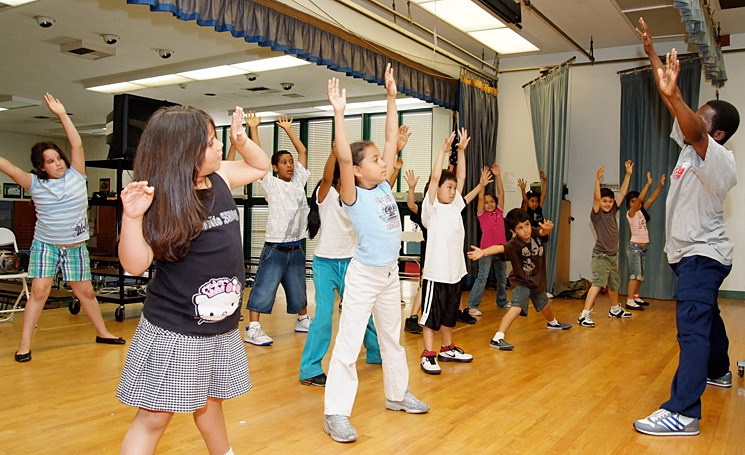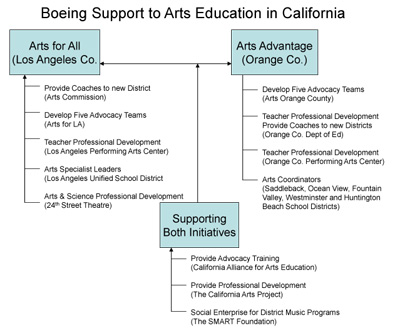« Previous Article | Next Article »
Partnering with others
Nurturing creative minds

Photo: Arts for All
Students at La Ballona Elementary School in Culver City Unified School District learn about dance as a performing art.
Coloring outside the lines
Sarah Murr exudes humor and passion when she talks about arts education and the importance of developing creative minds that will one day become the inventors and innovators who will drive the growth of business.
As Boeing's Global Corporate Citizenship community investor responsible for corporate giving to the arts in Southern California, Murr is considered a dedicated arts education advocate and was recently recognized by the Orange County Music and Arts Administrators for "Outstanding Contributions to Education" from the Orange County Board of Education.
"As an active board member of the California Alliance for Arts Education, she has spoken eloquently about the need for graduates of public schools to build their creative skills in order to meet the job force requirements of the future," according to the nomination.
“We know that employers are looking for new recruits who are creative problem solvers, innovative thinkers, confident communicators and collaborators. The arts provide all of that and more.”
—Sarah Murr, Boeing's Global Corporate Citizenship community investor responsible for corporate giving to the arts in Southern California.
Murr is only one of 75 Boeing community investors around the globe who are responsible for corporate giving in five interdependent community focus areas: arts and culture, education, environment, civic awareness and health and human services. Like her colleagues, Murr completes a thorough community needs assessment before determining whether an organization will receive Boeing grant funds. Requests are reviewed and approved annually.

For over 30 years, cuts in education have led to the disappearance of the arts in the public schools. "It's not surprising then that creativity is on the decline. While IQ continues to increase with each generation, creativity scores are decreasing. IBM's annual survey of 1,500 CEOs identified creativity as the number one leadership competency of the future," said Angel Ysaguirre, strategy director for Global Corporate Citizenship.
As with literacy, math and science, developing skills in the arts is complex. "For school-aged children, school is where they get the most exposure to the arts, especially for children from low income families," Ysaguirre added.
In response, education advocates in Los Angeles and Orange Counties in Southern California have developed a plan to put sequential, coordinated arts back in the schools. The key element of these arts education initiatives is the development of an infrastructure for each district that includes a policy and plan adopted by the school board, along with budget.
Today, as a result of Murr's hands-on role, Boeing supports programs in Los Angeles County and Orange County that do more than just provide financial support. Both Arts for All in Los Angeles County and Arts Advantage in Orange County are strategic arts-education initiatives, which help districts build policies and strategic and implementation plans, provide professional development for teachers and administrators, and develops curriculum in all four arts disciplines. Arts for All has been implemented in 43 of 81 Los Angeles County school districts representing more than 500,000 students. Arts Advantage has been implemented in 15 of 28 school districts representing nearly 350,000 students in Orange County.
In 2001, Los Angeles school districts were surveyed to obtain baseline data on arts education in their district. Most districts, 53 percent, reported they had no written plan for implementing arts education. And while 45 percent did report they had written plans, arts education was not being implemented across the district in a systematic manner, Murr explained.
"In Orange County, 38 percent of the districts had policies on the provision of arts education and 33 percent had written plans to implement arts education," she said.
In addition to providing support to allow school districts to develop arts curricula and train art teachers, "Advocacy is also a key element of each initiative," Murr said. "Large-scale change will never take place if parents and community leaders do not take ownership of for ensuring that the arts are in their children's schools. Our financial support has allowed the formation of Community Advocacy Teams, which include all community stakeholders, district personnel, business, parents, arts nonprofits and community leaders. These teams develop advocacy plans that support the individual needs of the district."
"The success of these programs will result in improving the lives of the students who participate by helping them build their creative capacity." Murr added. "We know that employers are looking for new recruits who are creative problem solvers, innovative thinkers, confident communicators and collaborators. The arts provide all of that and more."
